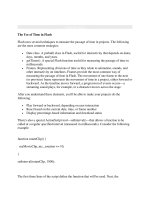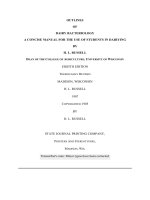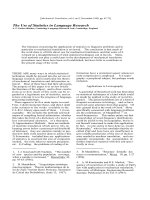The Use of Time in Flash
Bạn đang xem bản rút gọn của tài liệu. Xem và tải ngay bản đầy đủ của tài liệu tại đây (17.67 KB, 2 trang )
< Day Day Up >
The Use of Time in Flash
Flash uses several techniques to measure the passage of time in projects. The following
are the most common strategies:
•
Date class. A prebuilt class in Flash, useful for interactivity that depends on dates,
days, months, and years.
•
getTimer(). A special Flash function useful for measuring the passage of time in
milliseconds.
•
Frames. Representing divisions of time as they relate to animation, sounds, and
other interactivity on timelines. Frames provide the most common way of
measuring the passage of time in Flash. The movement of one frame to the next
(or previous) frame represents the movement of time in a project, either forward or
backward. As the timeline moves forward, a progression of events occurs—a
streaming sound plays, for example, or a character moves across the stage.
After you understand these elements, you'll be able to make your projects do the
following:
•
Play forward or backward, depending on user interaction
•
React based on the current date, time, or frame number
•
Display percentage-based information and download status
There's also a special ActionScript tool—setInterval()—that allows a function to be
called at a regular specified interval (measured in milliseconds). Consider the following
example:
function rotateClip() {
myMovieClip_mc._rotation += 10;
}
setInterval(rotateClip, 1500);
The first three lines of the script define the function that will be used. Next, the
setInterval() action is set up to call the rotateClip() function every 1.5 seconds (1,000
milliseconds equals 1 second).
If you want to pass arguments to the called function, simply add them to the setInterval()
action:
setInterval (updateMessageFunction, 20000, "Hello", arg2, arg3)
A setInterval() action can be turned on and off by assigning a variable name, as in the
following example:
var myInterval:Object = setInterval(rotateClip, 1500);
This example assigns the name myInterval to the setInterval() action. To remove the
functionality of the setInterval() action, use the following syntax:
clearInterval(myInterval);
Using the syntax shown, you can initiate the setInterval() action at any time, calling any
function.
< Day Day Up >









